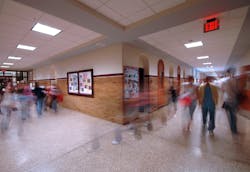A number of new technology trends are taking hold in the K-12 space as administrators and facility managers across the country seek out new ways to better secure their schools and protect their students. In turn, integrators are being asked to present the most robust and forward-thinking technologies available to meet these demands.
However, while some technologies can be shared across all schools, several solutions are specific to the type of building, location and use of a campus.
To help security professionals consider cutting-edge solutions for the campuses they serve, here are a few “challenge and solution” scenarios that have become more common over the past few years in terms of K-12 security solutions.
Universal Locking Solutions
One challenge we have seen is that school districts can feel pressure – from students, parents, and the community – to do “something” in the aftermath of an act of violence at a school elsewhere in the country. This pressure is justified, as keeping students safe and secure is among the primary missions of a school.
Adding to this challenge is that the market has become inundated with secondary-locking devices that make things much more dangerous for students and don’t provide much in the way of actual security. These devices come in the form of wedges, bars, or additional latches of some type that look to jam a door in place and in doing so they also violate fire and safety codes. Fire marshals will not sign off on these types of devices. And if they won’t take on that liability, then neither should the district.
It is a security professional’s job to provide schools with solutions when they seek answers for the problem. In this scenario, the correct solution is to deploy a complete opening – including the door, frame, and door hardware – that complies with the 5-aa10 test standards recommended by the FBI’s Active Shooter Report.
These complete Attack Resistant Openings – made of hollow metal construction and extremely resistant glass inserts – are technological marvels in that they are tested rigorously to withstand an intense four-minute physical attack with the use of hand tools after being shot 60 times with 7.62 NATO rounds.
There is a key differentiator here between the correct solution and products that violate code. One is a cutting-edge design and robust technological answer. The other is simply dangerous.
Lockdown Procedures
Another universal issue we see during consultation with schools is how to properly conduct lockdown procedures. The challenge here is that the narrative on best practices has evolved over the past few years.
Today’s best practice is to secure perimeter doors from a central location while allowing interior doors to be closed by staff and faculty using their own situational awareness. This requires providing the correct training for staff and implementing the correct technologies.
For an urban school, where it is easier to consolidate ingress and egress to just a few doors, it may be possible to rely on school resource officers or security guards to control access at the perimeter. An urban environment with few entrances can utilize the right blend of staff, video surveillance, and metal detectors to quickly provide the right response during a lockdown.
However, for urban environments that do have multiple entrances and exits, there is the need for an electronic access control system that can be locked down remotely. The Aperio wireless solution has been used in several deployments to allow for the flexibility of remote or local lockdown without the cost and complexity of hardwired locks.
In both scenarios, these access control solutions tie into sophisticated video surveillance and communications systems that allow for contact of first responders.
Rural schools
While rural schools can also benefit from a technology offering remote lockdown, they see additional challenges as these locations typically contain multiple perimeter openings across multiple buildings. Also, because rural campuses tend to build out rather than up, the acreage, sports facilities and parking lots also need to be secured. The resulting challenge is an abundance of keys and a difficult credential management process.
One solution to this challenge is implementing Intelligent Key Systems with eCylinders. These technological upgrades can be retrofit into almost any lock – from a traditional door in a school to a padlock on a chain-link fence. The brass key for these openings is then replaced by a smart key. This allows for an audit trail to be kept, for credentialing to be added or revoked using software, and for the elimination of costly rekeying if a key is lost.
We’ve seen a number of locations utilize this technology from single, one-off implementations at storage sheds where there are zero IT infrastructures to entire campus retrofits. In the most drastic scenarios, we see locations utilize this solution after rekeying has resulted in costs in the hundreds of thousands of dollars.
Simply put, if key control is a continuing issue, consider Intelligent Key technologies.
Storm Solutions
For 22 states, the need for high wind solutions is also critical. The challenges in these environments – whether it is hurricanes or tornados – are the need to meet code as mandated by the local, regional and federal governments. While tornados and hurricanes require different solutions, the same guidance applies: seek out manufacturers that provide FEMA rated solutions for doors and door hardware. These solutions must meet the most rigorous standards – be it tornadic level winds or hurricane pressure changes – and also be third-party certified by Underwriters Laboratories.
Partnering in success
To ensure security professionals are providing the appropriate solutions to schools, we always recommend they seek out a partnership with a manufacturer. Understanding all of the new technologies available for schools – be it for security and safety or for acoustic and thermal shielding – can be daunting. A manufacturer partner, however, can keep you abreast of all the emerging technologies as they prepare to go to market.
Further, the right manufacturing partner means you never have to worry about support disappearing. These companies are invested and engaged in the success of the integrator or other security provider and in meeting the needs of the end user. In turn, this ensures K-12 environments are being offered the right technologies and correct solutions to achieve our shared goal: keeping students, faculty and staff safe at school.
About the author: Ron Baer is Director of Business Development – K-12 for ASSA ABLOY Door Security Solutions.


